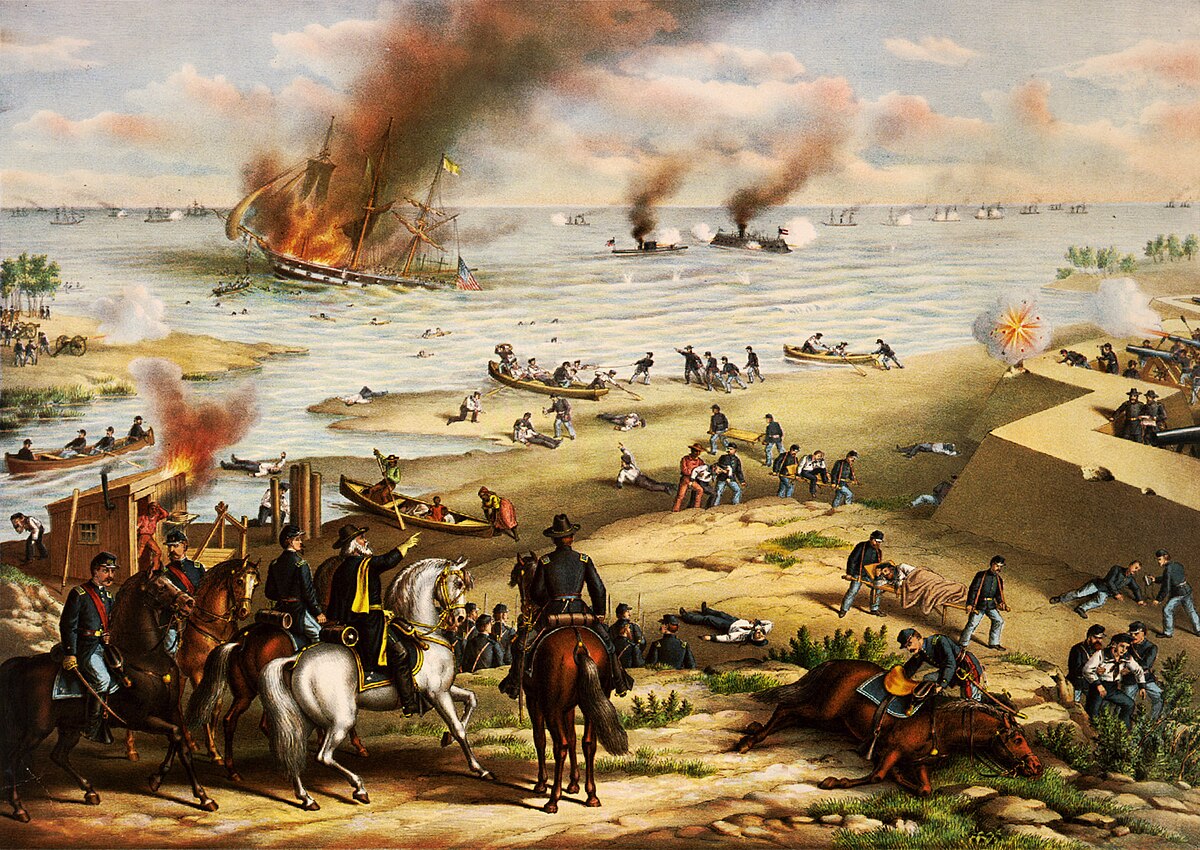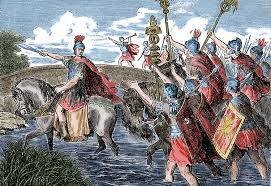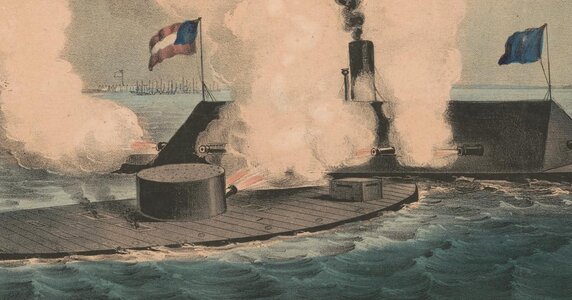Navigation
Install the app
How to install the app on iOS
Follow along with the video below to see how to install our site as a web app on your home screen.
Note: This feature may not be available in some browsers.
More options
You are using an out of date browser. It may not display this or other websites correctly.
You should upgrade or use an alternative browser.
You should upgrade or use an alternative browser.
Execution of Frankie Silver: This Date in History
- Thread starter donbosco
- Start date
- Replies: 853
- Views: 42K
- Off-Topic
- Messages
- 1,298
I have visited the Mariner's Museum in Newport News several times. And it is always a thrill to see the progress they continue to make in preserving the Monitor. But outside the Museum where you can walk on, under, and around the full size replica (outside) of the Monitor is just amazing. I'm sure that those with a better imagination than I have, when first seeing the replica of the Monitor think, "This looks about right." But for me, my first impression was, "This thing is huge!" The first time I saw the USS North Carolina, was on Saturday, October 14, 1961. It was huge, but I was expecting it to be huge. The replica of the Monitor was so much bigger than I expected, that in retrospect makes me wonder, "What was I expecting?" In reality, the Monitor was exactly the size it needed to be, not a foot to long or a foot too short.The Battle of Hampton Roads, also referred to as the Battle of the Monitor and Merrimack (actually the CSS Virginia, having been rebuilt and renamed) or the Battle of Ironclads, was a naval battle during the American Civil War.
The battle was fought over two days, March 8 and 9, 1862, in Hampton Roads, a roadstead in Virginia where the Elizabeth and Nansemond rivers meet the James River just before it flows into Chesapeake Bay by the city of Norfolk. The battle was a part of the effort of the Confederacy to break the Union blockade, which had cut off Virginia's largest cities and major industrial centers, Norfolk and Richmond, from international trade.[2][3] At least one historian has argued that, rather than trying to break the blockade, the Confederacy was simply trying to take complete control of Hampton Roads in order to protect Norfolk and Richmond.[4]
This battle was significant in that it was the first combat between ironclad warships, the USS Monitor and CSS Virginia. The Confederate fleet consisted of the ironclad ram Virginia (built from remnants of the burned steam frigate USS Merrimack, the newest warship of the Union Navy) and several supporting vessels. On the first day of battle, they were opposed by several conventional, wooden-hulled ships of the Union Navy.

Battle of Hampton Roads - Wikipedia
en.m.wikipedia.org
I British naval officer was present at the battle. He went back to London and told the Admiralty that their entire fleet of wooden ships was now obsolete.I have visited the Mariner's Museum in Newport News several times. And it is always a thrill to see the progress they continue to make in preserving the Monitor. But outside the Museum where you can walk on, under, and around the full size replica (outside) of the Monitor is just amazing. I'm sure that those with a better imagination than I have, when first seeing the replica of the Monitor think, "This looks about right." But for me, my first impression was, "This thing is huge!" The first time I saw the USS North Carolina, was on Saturday, October 14, 1961. It was huge, but I was expecting it to be huge. The replica of the Monitor was so much bigger than I expected, that in retrospect makes me wonder, "What was I expecting?" In reality, the Monitor was exactly the size it needed to be, not a foot to long or a foot too short.
- Messages
- 1,298
Which apparently was exactly the effect that John Erricsson hoped it would have. He named it the "Monitor" as a warning to the British that vessels like it would be "monitoring" the activity of the British. And in another 15 years or so, the US did have seagoing "Monitors" that could make it around the bottom of South America.I British naval officer was present at the battle. He went back to London and told the Admiralty that their entire fleet of wooden ships was now obsolete.
- Messages
- 1,298
And that the Monitor went from blueprints to floating in the Hudson River in Edit/four months/Edit "has always seemed to epitomize the nature of" the United States.The Monitor/Merrimac battle and the design of the respective vessels has always seemed to epitomize the nature of the two sides in that conflict.
Last edited:
- Messages
- 1,102
1893 New Mexico State University cancels its first graduation ceremony, because the only graduate was robbed and killed the night before.
On to something a bit more impactful. Well, i've used the term on occasion.
49 Julius Caesar crosses the Rubicon and invades Italy. "Crossing the Rubicon" is an idiom that means to make a final, irrevocable decision or to pass a point of no return. It refers to Julius Caesar's act of crossing the Rubicon River with his army in 49 BC, which broke an ancient law and ignited a civil war in Rome. The Rubicon was a small stream that separated Rome from Gaul. By crossing it, Caesar defied the law that prohibited generals from entering Italy with an army, making war inevitable.

On to something a bit more impactful. Well, i've used the term on occasion.
49 Julius Caesar crosses the Rubicon and invades Italy. "Crossing the Rubicon" is an idiom that means to make a final, irrevocable decision or to pass a point of no return. It refers to Julius Caesar's act of crossing the Rubicon River with his army in 49 BC, which broke an ancient law and ignited a civil war in Rome. The Rubicon was a small stream that separated Rome from Gaul. By crossing it, Caesar defied the law that prohibited generals from entering Italy with an army, making war inevitable.

donbosco
Inconceivable Member
- Messages
- 3,656
#OTD (March 10) in 1948 the main building at Asheville’s Highland Hospital burned to the ground. Nine women died, including Zelda Fitzgerald, the wife of author F. Scott Fitzgerald. Highland’s business was in treating ‘nervous disorders.’ Psychiatrist Dr. Robert S. Carroll had opened his ‘sanatorium’ in 1904 to treat those with “nervous disease” as mental and emotional disorders were known at the time. Addiction was also addressed by treatments at Highland.
Dr. Carroll gave over the facility to the Duke University Neuropsychiatric Department in 1939. Under Duke management, exercise, especially mountain trekking, was stressed as a regimen for the patients. Zelda Fitzgerald’s biographer, Nancy Milford wrote of the place in 1970: “This was not hiking, nor was it supposed to be a particularly enjoyable exercise; it was to teach the disturbed to overcome obstacles by learning perseverance. A nurse who was at the hospital at the time said that the exercise ‘was to accustom the patient to the reality of endeavor, endless and routine. The monotonous plodding along of everyday life might be a sound analogy.’”
Zelda herself wrote of Highland in letters to Scott, “For as long as a year, Highland Hospital is a excellent a regime as I know; but it’s the only hospital that I have ever been in that makes no provisions for any personal life –[leisure, right of opinion, liberties such as town etc.] –and after three years of such, the soul begins to perish.” (From Bryer and Barks. Dear Scott, Dearest Zelda, 2002)
The facility had fire escapes but no sprinkler system and a dumb waiter system actually served to move the fire, started from an electric coffee urn left on in the kitchen, through the structure with great speed. A March 12 Asheville Citizen article noted that firemen were thwarted in their rescue by “heavily screened porches and windows shackled with chains as a precautionary measure to keep patients from jumping out.” (From Tuesday History: The fire at Highland Hospital) Eleven patients were saved just the same.
Today there is a memorial plaque nearby the location on private property at 163 Zillacoa Street that lists the names of the eleven who died. It also bears a quotation by F. Scott Fitzgerald that reads, “I don’t need anything except hope, which I can’t find by looking backwards or forwards, so I suppose the thing is to shut my eyes.” The ‘Mountain Times’ link and this one from The NC Department of Cultural Resources has more: Zelda Fitzgerald Casualty of Hospital Fire, 1948
Dr. Carroll gave over the facility to the Duke University Neuropsychiatric Department in 1939. Under Duke management, exercise, especially mountain trekking, was stressed as a regimen for the patients. Zelda Fitzgerald’s biographer, Nancy Milford wrote of the place in 1970: “This was not hiking, nor was it supposed to be a particularly enjoyable exercise; it was to teach the disturbed to overcome obstacles by learning perseverance. A nurse who was at the hospital at the time said that the exercise ‘was to accustom the patient to the reality of endeavor, endless and routine. The monotonous plodding along of everyday life might be a sound analogy.’”
Zelda herself wrote of Highland in letters to Scott, “For as long as a year, Highland Hospital is a excellent a regime as I know; but it’s the only hospital that I have ever been in that makes no provisions for any personal life –[leisure, right of opinion, liberties such as town etc.] –and after three years of such, the soul begins to perish.” (From Bryer and Barks. Dear Scott, Dearest Zelda, 2002)
The facility had fire escapes but no sprinkler system and a dumb waiter system actually served to move the fire, started from an electric coffee urn left on in the kitchen, through the structure with great speed. A March 12 Asheville Citizen article noted that firemen were thwarted in their rescue by “heavily screened porches and windows shackled with chains as a precautionary measure to keep patients from jumping out.” (From Tuesday History: The fire at Highland Hospital) Eleven patients were saved just the same.
Today there is a memorial plaque nearby the location on private property at 163 Zillacoa Street that lists the names of the eleven who died. It also bears a quotation by F. Scott Fitzgerald that reads, “I don’t need anything except hope, which I can’t find by looking backwards or forwards, so I suppose the thing is to shut my eyes.” The ‘Mountain Times’ link and this one from The NC Department of Cultural Resources has more: Zelda Fitzgerald Casualty of Hospital Fire, 1948
- Messages
- 2,558
I has a friend at Highland I visited a couple of times . Maybe 1990? Earlier she had been my Cub Scout Asst leader as I was the Packmaster . She did all the work in planning crafts etc -I was the "face"#OTD (March 10) in 1948 the main building at Asheville’s Highland Hospital burned to the ground. Nine women died, including Zelda Fitzgerald, the wife of author F. Scott Fitzgerald. Highland’s business was in treating ‘nervous disorders.’ Psychiatrist Dr. Robert S. Carroll had opened his ‘sanatorium’ in 1904 to treat those with “nervous disease” as mental and emotional disorders were known at the time. Addiction was also addressed by treatments at Highland.
Dr. Carroll gave over the facility to the Duke University Neuropsychiatric Department in 1939. Under Duke management, exercise, especially mountain trekking, was stressed as a regimen for the patients. Zelda Fitzgerald’s biographer, Nancy Milford wrote of the place in 1970: “This was not hiking, nor was it supposed to be a particularly enjoyable exercise; it was to teach the disturbed to overcome obstacles by learning perseverance. A nurse who was at the hospital at the time said that the exercise ‘was to accustom the patient to the reality of endeavor, endless and routine. The monotonous plodding along of everyday life might be a sound analogy.’”
Zelda herself wrote of Highland in letters to Scott, “For as long as a year, Highland Hospital is a excellent a regime as I know; but it’s the only hospital that I have ever been in that makes no provisions for any personal life –[leisure, right of opinion, liberties such as town etc.] –and after three years of such, the soul begins to perish.” (From Bryer and Barks. Dear Scott, Dearest Zelda, 2002)
The facility had fire escapes but no sprinkler system and a dumb waiter system actually served to move the fire, started from an electric coffee urn left on in the kitchen, through the structure with great speed. A March 12 Asheville Citizen article noted that firemen were thwarted in their rescue by “heavily screened porches and windows shackled with chains as a precautionary measure to keep patients from jumping out.” (From Tuesday History: The fire at Highland Hospital) Eleven patients were saved just the same.
Today there is a memorial plaque nearby the location on private property at 163 Zillacoa Street that lists the names of the eleven who died. It also bears a quotation by F. Scott Fitzgerald that reads, “I don’t need anything except hope, which I can’t find by looking backwards or forwards, so I suppose the thing is to shut my eyes.” The ‘Mountain Times’ link and this one from The NC Department of Cultural Resources has more: Zelda Fitzgerald Casualty of Hospital Fire, 1948
- Messages
- 1,102
A friend was badly torn up in a car wteck. His sister and I drove up from CH. Got a buzz; even knocked back a 6 pack (early 80s). Got to his room. He looked like death. The smell in the room smelled like death. I had to get out. I remember reaching for the nurse station and rhe next thing you know I'm on my back with a nurse is over me with a smelling salt. I look over and here comes my friend's father just arriving. Stops and shakes his head. Very cool guy he was.
Friend never recovered.
Friend never recovered.
donbosco
Inconceivable Member
- Messages
- 3,656
I has a friend at Highland I visited a couple of times . Maybe 1990? Earlier she had been my Cub Scout Asst leader as I was the Packmaster . She did all the work in planning crafts etc -I was the "face"
Could it have been earlier? Dook closed the place in 1980.
donbosco
Inconceivable Member
- Messages
- 3,656
A friend was badly torn up in a car wteck. His sister and I drove up from CH. Got a buzz; even knocked back a 6 pack (early 80s). Got to his room. He looked like death. The smell in the room smelled like death. I had to get out. I remember reaching for the nurse station and rhe next thing you know I'm on my back with a nurse is over me with a smelling salt. I look over and here comes my friend's father just arriving. Stops and shakes his head. Very cool guy he was.
Friend never recovered.
This happened to you on March 10?
A friend was badly torn up in a car wteck. His sister and I drove up from CH. Got a buzz; even knocked back a 6 pack (early 80s). Got to his room. He looked like death. The smell in the room smelled like death. I had to get out. I remember reaching for the nurse station and rhe next thing you know I'm on my back with a nurse is over me with a smelling salt. I look over and here comes my friend's father just arriving. Stops and shakes his head. Very cool guy he was.
Friend never recovered.
- Messages
- 1,102
Nope. Just threw that in here for whatever. A bit loopy today.This happened to you on March 10?
donbosco
Inconceivable Member
- Messages
- 3,656
Nope. Just threw that in here for whatever. A bit loopy today.
Gotcha.
- Messages
- 2,558
I could be wrongCould it have been earlier? Dook closed the place in 1980.
It was a Psych Hospital in Asheville Was after 1980 for sure???
donbosco
Inconceivable Member
- Messages
- 3,656
I could be wrong
It was a Psych Hospital in Asheville Was after 1980 for sure???
I mispoke...the link says that they "closed the unit in the 1980s" not IN 1980. I remember that Lee Smith's son Josh was there in the 1980s. She wrote a book about the hospital during the Zelda years and in an interview she mentioned that she knew the place personally because of that reason. Shelf Awareness for Readers for Tuesday, October 15, 2013
- Messages
- 2,558
I remember there was a patient there-long term-he had something crazy like a $1,000 bill he would show folks He was an heir to the Tabsco Sauce fortuneI mispoke...the link says that they "closed the unit in the 1980s" not IN 1980. I remember that Lee Smith's son Josh was there in the 1980s. She wrote a book about the hospital during the Zelda years and in an interview she mentioned that she knew the place personally because of that reason. Shelf Awareness for Readers for Tuesday, October 15, 2013
donbosco
Inconceivable Member
- Messages
- 3,656
Lee Smith’s Guests on Earth is set in Highland Hospital in the ‘30’s and ‘40’s. A fictionalized Zelda Fitzgerald is in the book.
Missed this post...referenced Guests above.
Share:

